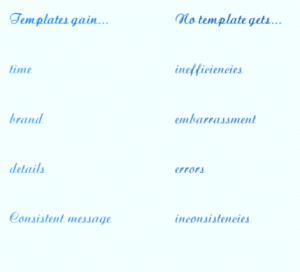I hope you find my writing and business tips and observations useful. My business and blog are dedicated to helping businesses communicate clearly and reach their potential.
Read, subscribe to my newsletter, enjoy!Tash
How businesses can use templates
So I’ve posted about poor template use and given some tips on maximising your use of templates.
But maybe you’re wondering what sorts of templates you could use in the first place. Or whether it is worth the effort to prepare a template.
What are templates for?
Templates are great for
- saving time as you don’t have to start a document from scratch each time you use it. This applies to commonly used documents (so you save time regularly) and infrequently used documents (so you don’t have to search for the ‘last time you did something like this’ to find the details).
- ensuring consistency over time and between staff members. A template means everyone says the same thing so there is no confusion.
- building your brand through consistency in style as well as consistency in the actual message. Imagine one staff member writes formal letters while another writes casual letters in the same circumstances – a template means both use the same style.
- ensuring all important details are included. In the rush of everyday, it is easy to write something and forget a particular detail; a carefully prepared template will have those details (either in full or as a field for you to enter the correct information)
So, what templates can we use?
Ok, that’s as easy as answering ‘what letters can we use in our business?’
There are many different things that can be put into a template for improved efficiency and branding. So this list is a sample to get you thinking of what can be changed in your business.
- one-off use of major business document templates like a style guide, marketing plan, business plan and personnel manuals. (Note by one-off I mean the template is generally used once but the document itself is updated periodically).
- regularly used documents such as sales letters, enquiry letters/emails, welcome letters, overdue accounts notices
- briefs for suppliers such as writers, designers, programmers
- an outline template for items such as blog posts, management reports and media releases
- general stationery can be set up as templates – for example, a letterhead can have the date/name/address/greeting fields prepared and a prepared minutes format can make reporting on meetings much easier
- technical and/or legal documents such as terms and conditions for competitions, customer contracts and instruction manuals/guides.
What other templates have you used that have made your business life a bit simpler and easier?





Leave a Reply